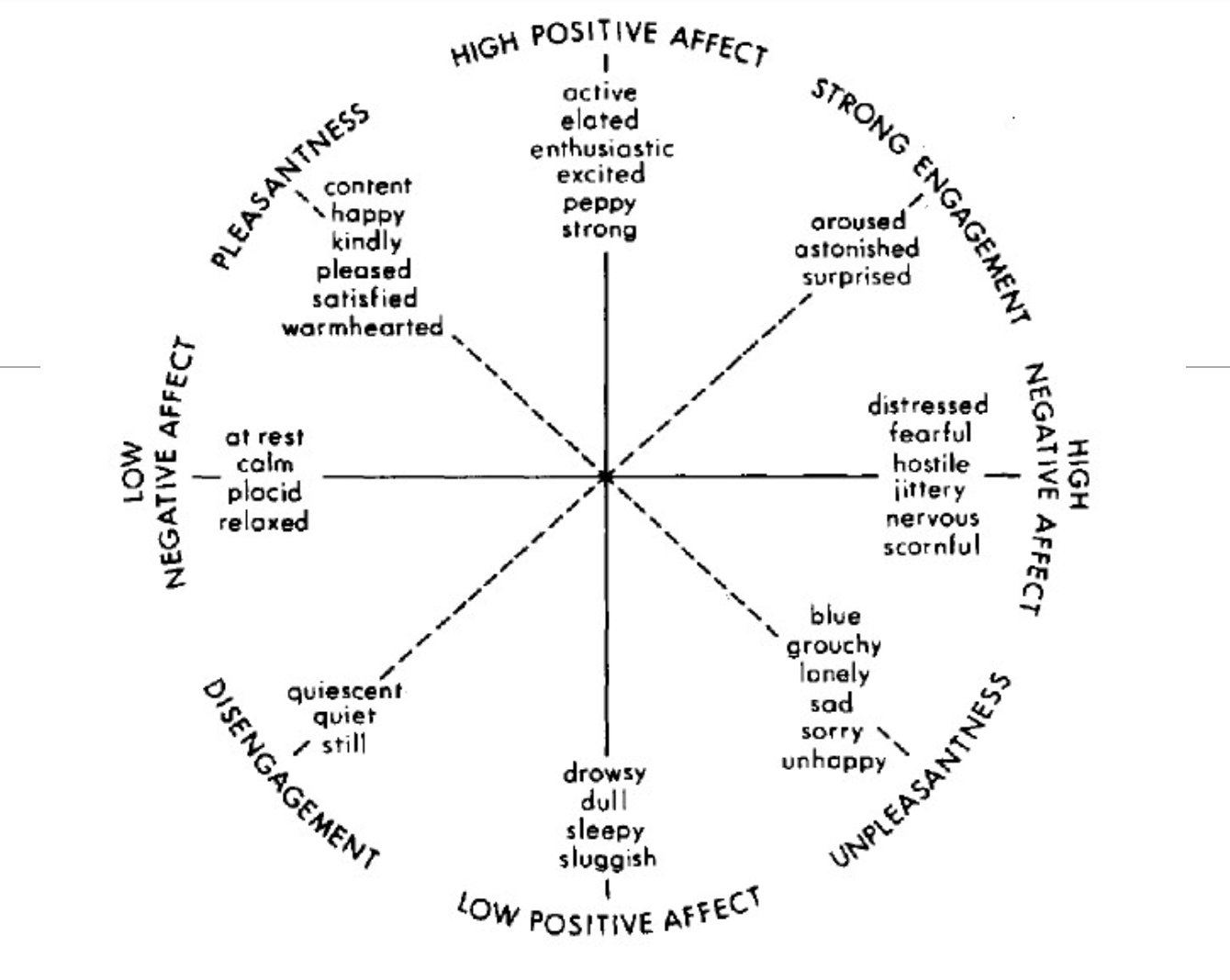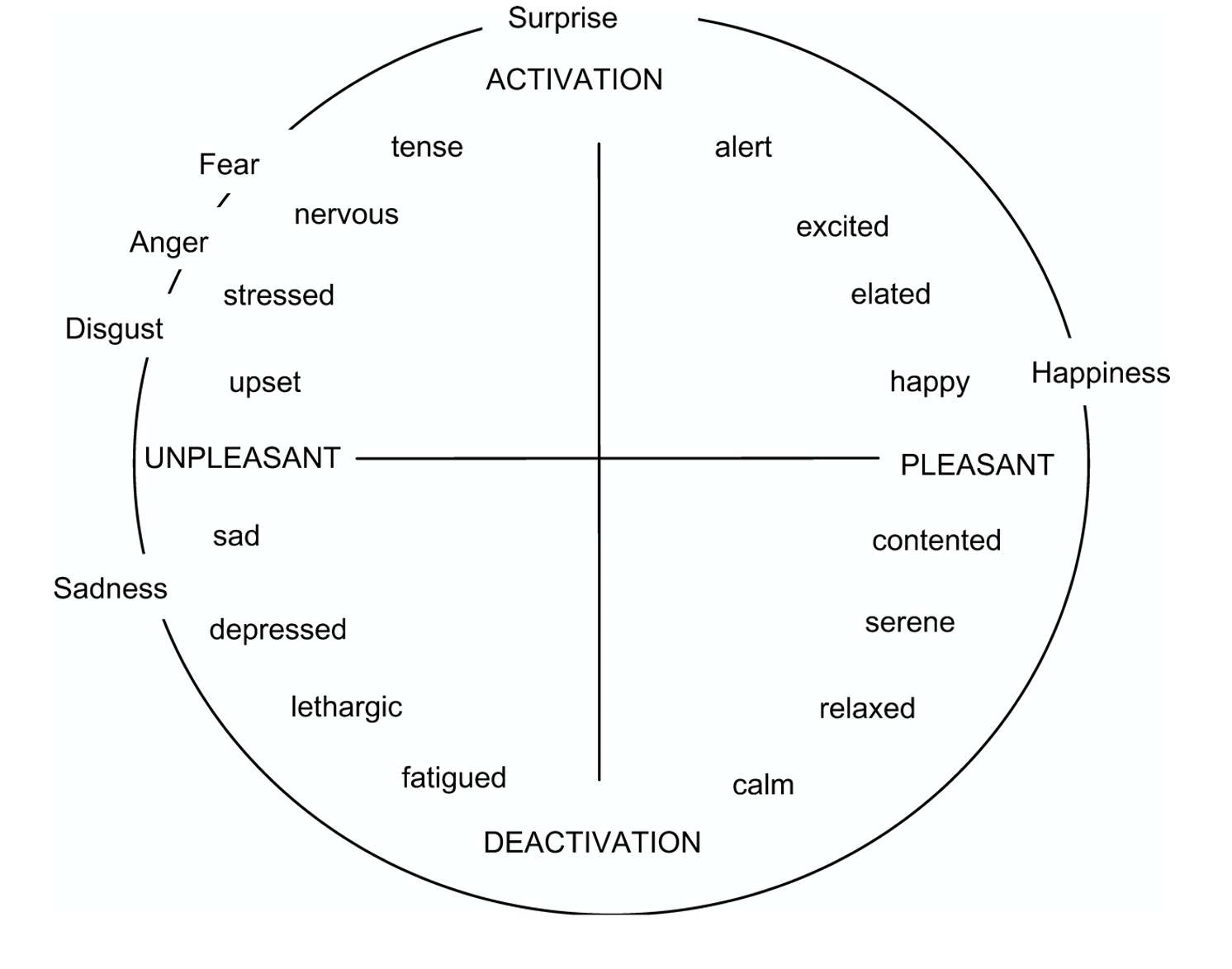Chapter 8: Fear, Anxiety, and Stress
Fear: Subjective Feelings
Dimensional models view fear as highly unpleasant and highly arousing. Russell’s (1980; see Figure 4) model views fear as higher in arousal than anger and disgust, but equal in unpleasantness. Compared to surprise, fear is lower in arousal, but higher in unpleasantness.
Figure 4
Russell’s (1980) Circumplex Model
Long Description
This image is a circular diagram that organizes emotions along two intersecting axes:
Axes
- Vertical Axis:
- Top = Activation
- Bottom = Deactivation
- Horizontal Axis:
- Left = Unpleasant
- Right = Pleasant
These axes divide the circle into four emotional quadrants, each representing a combination of valence (pleasantness) and arousal (activation level):
Quadrants and Emotions
- Activation + Unpleasant (Top Left):
- Emotions: Tense, Nervous, Stressed, Upset
- Activation + Pleasant (Top Right):
- Emotions: Alert, Excited, Elated, Happy
- Deactivation + Unpleasant (Bottom Left):
- Emotions: Sad, Depressed, Lethargic, Fatigued
- Deactivation + Pleasant (Bottom Right):
- Emotions: Contented, Serene, Relaxed, Calm
Key Emotions at Axis Points
- Surprise is placed at the top (high activation).
- Sadness is at the bottom (low activation).
- Fear, Anger, Disgust are on the left (unpleasant).
- Happiness is on the right (pleasant).
This model visually represents how emotions vary in both intensity and valence, helping to explain emotional experiences in a two-dimensional space.
Reproduced from “Independence and bipolarity in the structure of current affect,” by L. Feldman Barrett and J.A. Russell, 1998, Journal of Personality and Social Psychology, 74(4), p. 970 (Independence and bipolarity in the structure of current affect.). Copyright 1998 by the American Psychological Association.
Watson and Tellegen’s circumplex (1985; see Figure 5) views fear as high in NA, suggesting that fear is a highly activating negative emotion. In addition, this model views fear and anger (i.e., “hostile”) as similar in activation and unpleasantness. Compared to surprise, fear is more unpleasant and lower in arousal.
Figure 5
Watson and Tellegen’s (1985) Circumplex Model

Long Description
The image is a circular diagram that illustrates different affective states positioned around two intersecting axes. The vertical axis ranges from “Low Negative Affect” at the bottom to “High Positive Affect” at the top. The horizontal axis ranges from “Pleasantness” on the left to “Unpleasantness” on the right. The circle is also divided into quadrants by diagonal lines, indicating “Disengagement” at the bottom left, “Strong Engagement” at the top right, “Low Positive Affect” at the bottom, and “High Negative Affect” at the right side. Each section contains words that describe emotions associated with varying degrees of these affective states. For example, the upper right section labeled “High Positive Affect, Strong Engagement” lists emotions such as “active,” “elated,” and “enthusiastic.” The bottom right section signifies “Low Positive Affect” with words like “drowsy” and “dull.” The left side features “Low Negative Affect, Disengagement” with terms like “at rest” and “calm.” The right side under “High Negative Affect” includes emotions such as “distressed” and “fearful.”


